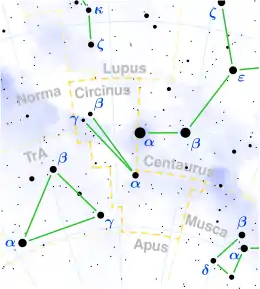Delta Circini
Delta Circini (δ Cir), is a multiple star system located in the constellation Circinus. Delta Circini is also known as HR 5664, and HD 135240. The system has a combined apparent visual magnitude of +5.09, and is located at a distance of 770 pc (2,500ly) from the Sun.
 | |
| Observation data Epoch J2000.0 Equinox J2000.0 | |
|---|---|
| Constellation | Circinus |
| Right ascension | 15h 16m 56.89610s[1] |
| Declination | −60° 57′ 26.1072″[1] |
| Apparent magnitude (V) | 5.09[2] (5.05 - 5.20[3]) |
| Characteristics | |
| Spectral type | O7.5III(f)[3] (O8IV[3] + O9.5V + B0.5V([4]) |
| U−B color index | -0.88[2] |
| B−V color index | -0.06[2] |
| Variable type | Eclipsing and ellipsoidal[3] |
| Astrometry | |
| Radial velocity (Rv) | −17.80[5] km/s |
| Proper motion (μ) | RA: -1.90[1] mas/yr Dec.: -3.06[1] mas/yr |
| Parallax (π) | 0.89 ± 0.30[1] mas |
| Distance | 770[3] pc |
| Orbit[3] | |
| Primary | Aa |
| Companion | Ab |
| Period (P) | 3.902463 days |
| Semi-major axis (a) | 34.7 R☉ |
| Eccentricity (e) | 0.068 |
| Inclination (i) | 75.81° |
| Semi-amplitude (K1) (primary) | 156.8 km/s |
| Semi-amplitude (K2) (secondary) | 280.4 km/s |
| Orbit[3] | |
| Primary | Aab |
| Companion | Ac |
| Period (P) | 1,644 days |
| Semi-major axis (a) | 3.87″ |
| Eccentricity (e) | 0.415 |
| Inclination (i) | 87.7° |
| Semi-amplitude (K1) (primary) | 23.6 km/s |
| Details[3] | |
| Aa | |
| Mass | 23.6 M☉ |
| Radius | 9.20 R☉ |
| Luminosity | 20,000 L☉ |
| Surface gravity (log g) | 3.88 cgs |
| Temperature | 34,000 K |
| Ab | |
| Mass | 13.2 M☉ |
| Radius | 5.73 R☉ |
| Luminosity | 21,000 L☉ |
| Surface gravity (log g) | 4.04 cgs |
| Temperature | 29,000 K |
| Ac | |
| Mass | 18.7 M☉ |
| Luminosity | 17,000 L☉ |
| Surface gravity (log g) | 4.2 cgs |
| Temperature | 28,000 K |
| Other designations | |
| Database references | |
| SIMBAD | data |
Companions
δ Circini A is a spectroscopic triple star, although the outer component has been resolved using the VLTI PIONIER instrument. The two inner components form an eclipsing binary system.[3]
δ Circini B is a 13th magnitude companion nearly an arc-second away. It is unclear whether the two are physically associated and little is known about the fainter star although it has been reported to be a G5 main sequence star or giant.[6]
HD 135160 is a 6th magnitude binary Be star that shares a common space motion with δ Circini and is only 4 arc minutes away. The two make a faint naked eye pair.
System properties
All three components of δ Circini A are hot luminous stars. The brightest is an O8 star just beginning to evolve away from the main sequence. It is in a very close orbit with an O9.5 main sequence star. The two stars are deformed into ellipsoidal shapes and eclipse each other every 3.9 days. The total brightness change is only 0.15 magnitudes.
The third component is a B0.5 main sequence star in a long eccentric orbit around the close pair. It is fainter and cooler than either of the two close stars, yet it is calculated to be more massive than δ Cir A, so it is suspected that it may also be a close binary system.[3]
References
- Van Leeuwen, F. (2007). "Validation of the new Hipparcos reduction". Astronomy and Astrophysics. 474 (2): 653–664. arXiv:0708.1752. Bibcode:2007A&A...474..653V. doi:10.1051/0004-6361:20078357. S2CID 18759600.
- Ducati, J. R. (2002). "VizieR Online Data Catalog: Catalogue of Stellar Photometry in Johnson's 11-color system". CDS/ADC Collection of Electronic Catalogues. 2237. Bibcode:2002yCat.2237....0D.
- Mayer, Pavel; Harmanec, Petr; Sana, Hugues; Le Bouquin, Jean-Baptiste (2014). "The Three-body System δ Circini". The Astronomical Journal. 148 (6): 114. arXiv:1408.1958. Bibcode:2014AJ....148..114M. doi:10.1088/0004-6256/148/6/114. S2CID 118333313.
- Penny, Laura R.; Seyle, Debra; Gies, Douglas R.; Harvin, James A.; Bagnuolo, William G.; Thaller, M. L.; Fullerton, A. W.; Kaper, L. (2001). "Tomographic Separation of Composite Spectra. VII. The Physical Properties of the Massive Triple System HD 135240 (δ Circini)". The Astrophysical Journal. 548 (2): 889. Bibcode:2001ApJ...548..889P. doi:10.1086/319031.
- Pourbaix, D.; Tokovinin, A. A.; Batten, A. H.; Fekel, F. C.; Hartkopf, W. I.; Levato, H.; Morrell, N. I.; Torres, G.; Udry, S. (2004). "SB9: The ninth catalogue of spectroscopic binary orbits". Astronomy and Astrophysics. 424 (2): 727–732. arXiv:astro-ph/0406573. Bibcode:2004A&A...424..727P. doi:10.1051/0004-6361:20041213. S2CID 119387088.
- Lindroos, K. P. (1985). "A study of visual double stars with early type primaries. IV Astrophysical data". Astronomy and Astrophysics Supplement Series. 60: 183. Bibcode:1985A&AS...60..183L.